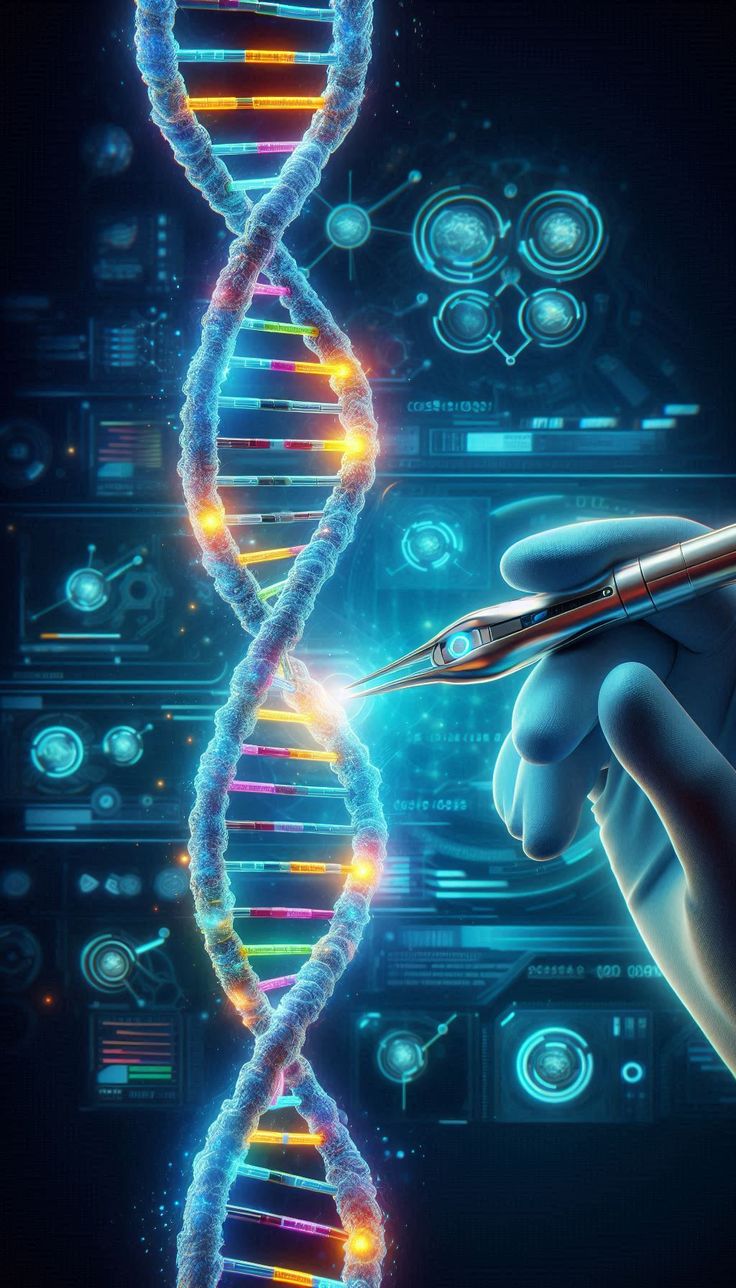Biotechnology and CRISPR Gene Editing: Unlocking the Potential of Genetic Innovation in 2025
Biotechnology and CRISPR Gene Editing: The intersection of biotechnology and gene editing is one of the most exciting areas of scientific research in 2025, and at the forefront of this revolution is CRISPR (Clustered Regularly Interspaced Short Palindromic Repeats), a groundbreaking gene-editing technology. Biotechnology, in combination with CRISPR, is poised to transform medicine, agriculture, and environmental conservation in ways that were once considered science fiction. With ongoing advancements in gene editing, these technologies hold the promise of curing genetic diseases, improving crop yields, and addressing pressing global challenges such as climate change and food security.
In this article, we explore the current state of biotechnology and CRISPR gene editing, their potential applications in various industries, and the ethical considerations and challenges that come with these innovations.
What is Biotechnology?
Biotechnology refers to the use of biological systems, organisms, or derivatives to develop or create new products and processes. It has been employed across a wide range of industries, including medicine, agriculture, and environmental management, to enhance human health and quality of life. By harnessing the power of biology, biotechnology enables scientists to manipulate cells, genes, and proteins to develop new drugs, vaccines, therapies, and sustainable solutions for global challenges.
Some key areas of biotechnology include:
- Medical Biotechnology: The development of new drugs, vaccines, and gene therapies.
- Agricultural Biotechnology: The creation of genetically modified crops to enhance food security and agricultural sustainability.
- Environmental Biotechnology: Using microorganisms and enzymes to address pollution, waste management, and energy production.
The CRISPR Gene Editing Revolution: Biotechnology and CRISPR Gene Editing
CRISPR technology is one of the most significant breakthroughs in the field of biotechnology in recent years. First discovered in bacteria as a defense mechanism against viruses, CRISPR has since been adapted as a precise, efficient tool for editing genes in living organisms. The CRISPR-Cas9 system, which uses a molecular “scissor” to cut DNA at specific locations, allows scientists to add, delete, or alter genes with remarkable accuracy.
In 2025, CRISPR technology has advanced far beyond its initial applications in laboratory research. The scope of its potential is vast, with applications ranging from medicine and genetic disorders to agriculture and environmental protection.
Key Applications of CRISPR in Biotechnology: Biotechnology and CRISPR Gene Editing
1. Medical Biotechnology and Gene Therapy; Biotechnology and CRISPR Gene Editing
One of the most significant applications of CRISPR technology is in the treatment of genetic diseases. By editing defective genes at the DNA level, CRISPR has the potential to cure or mitigate a wide variety of genetic disorders. Diseases such as sickle cell anemia, cystic fibrosis, muscular dystrophy, and Huntington’s disease could potentially be treated using CRISPR-based gene therapies.
In 2025, several clinical trials using CRISPR technology to treat genetic diseases are already underway, with promising results. For instance, patients with sickle cell anemia have shown significant improvement after receiving CRISPR-edited stem cell transplants. These breakthroughs could pave the way for the development of personalized gene therapies that target the root cause of genetic diseases rather than just treating symptoms.
Furthermore, CRISPR is being explored for its potential to modify immune cells to fight diseases like cancer. By editing immune cells to recognize and attack cancer cells more effectively, researchers are developing CRISPR-based immunotherapies that could revolutionize cancer treatment.
2. Agricultural Biotechnology and Food Security; Biotechnology and CRISPR Gene Editing
CRISPR is also making waves in agriculture, where it is being used to develop genetically modified crops that are more resilient, nutritious, and efficient. In 2025, CRISPR is being used to create crops with enhanced traits such as improved resistance to pests, drought tolerance, and better nutritional content. Unlike traditional genetic modification techniques, which often involve inserting foreign genes, CRISPR allows for more precise edits, reducing the risk of unintended side effects.
Some key examples of CRISPR in agriculture include:
- Drought-resistant crops: By editing specific genes in crops like rice and corn, scientists have developed varieties that can thrive in water-scarce environments, helping to ensure food security in regions affected by climate change.
- Improved nutrient content: CRISPR has been used to increase the levels of essential nutrients like vitamin A in crops such as rice, which could help combat malnutrition in developing countries.
- Disease-resistant plants: CRISPR is being used to create crops that are resistant to viral infections, such as banana and potato varieties that are resistant to diseases like banana wilt and late blight, which have decimated crops in recent years.
3. Environmental Biotechnology and Climate Solutions; Biotechnology and CRISPR Gene Editing
The potential of CRISPR in addressing environmental challenges is also being explored. In 2025, researchers are investigating how gene editing could be used to create organisms that can help mitigate the effects of climate change. Some potential applications of CRISPR in environmental biotechnology include:
- Carbon capture: By editing microorganisms to enhance their ability to capture and store carbon dioxide, CRISPR could play a role in reducing the amount of carbon in the atmosphere and combating global warming.
- Bioremediation: CRISPR could be used to engineer bacteria or fungi to clean up oil spills, toxins, and pollutants in the environment. These organisms could be engineered to break down harmful substances into harmless byproducts, offering a sustainable solution to pollution.
Additionally, CRISPR could be used to create more sustainable agricultural practices by reducing the need for harmful pesticides, herbicides, and fertilizers. This would result in less environmental pollution and a reduced ecological footprint for farming practices.
Ethical Considerations and Challenges: Biotechnology and CRISPR Gene Editing
Despite the immense potential of CRISPR and gene editing, there are important ethical considerations and challenges that need to be addressed. Some of the key concerns include:
1. Germline Editing and Designer Babies; Biotechnology and CRISPR Gene Editing
One of the most controversial aspects of CRISPR technology is its ability to edit germline cells, which are the cells that contribute to the genetic makeup of future generations. Editing the germline could potentially eliminate genetic diseases from a family lineage, but it also raises concerns about the potential for designer babies—children whose genetic traits, such as intelligence, physical appearance, or athletic ability, are selected or modified by parents.
Many ethical debates center around whether it is appropriate to modify the human genome in ways that could affect future generations. There is also concern about the potential for genetic inequality if such technologies are only accessible to the wealthy.
2. Off-Target Effects and Safety; Biotechnology and CRISPR Gene Editing
While CRISPR is highly precise, it is not perfect. Off-target effects, where unintended sections of DNA are edited, could potentially have harmful consequences. In the context of gene therapy, unintended edits could result in harmful mutations or even cancer. Researchers are working to improve the accuracy of CRISPR technology to reduce these risks.
3. Environmental Risks; Biotechnology and CRISPR Gene Editing
When CRISPR is used in agriculture or environmental applications, there is a concern about the potential impact on ecosystems. For example, if genetically modified organisms are released into the wild, they could disrupt natural ecosystems or crossbreed with wild populations, leading to unintended ecological consequences. Careful regulation and testing are required to ensure the safety of gene-edited organisms.
The Future of Biotechnology and CRISPR Gene Editing
Biotechnology and CRISPR Gene Editing: The future of biotechnology and CRISPR gene editing in 2025 is incredibly promising, with the potential to revolutionize medicine, agriculture, and environmental conservation. As CRISPR technology continues to evolve and improve, its applications will expand, and we are likely to see more gene therapies, genetically modified crops, and environmentally friendly solutions to global challenges.
However, with these advancements come significant ethical and safety considerations. It is essential for researchers, policymakers, and society as a whole to carefully navigate these issues to ensure that the benefits of biotechnology and gene editing are realized in a responsible and ethical manner.
In conclusion, CRISPR gene editing and biotechnology are not just scientific marvels—they are the key to unlocking new possibilities for improving human health, feeding the growing global population, and addressing environmental crises. With continued innovation and careful oversight, these technologies will undoubtedly play a central role in shaping the future.










